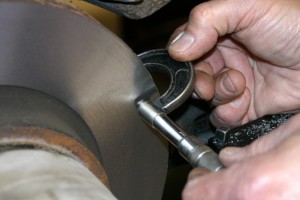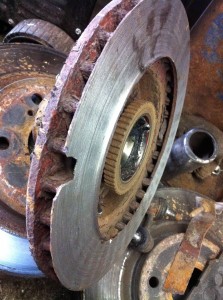 By the second or third brake job, it’s likely the vehicle will need rotors/discs.
By the second or third brake job, it’s likely the vehicle will need rotors/discs.
As rotors wear and become thinner, they also become weaker and are less able to absorb and dissipate heat. This increases the risk of the brakes overheating as well as rotor failure.
All rotors have a minimum thickness and/or discard specification that’s usually stamped or cast onto the rotor itself. If a rotor is worn down to this specification (you must use a micrometer to measure the thickness), or it cannot be resurfaced without exceeding this dimension, the rotor must be replaced.
 Rotors can also wear unevenly. This is often due to excessive runout in the rotor, or from hard spots in the surface of the rotor. In many instances, rotors can be distorted if the lug nuts are not evenly torqued. Dirt or rust that’s trapped between the rotor and hub can also cause the same kind of distortion.
Rotors can also wear unevenly. This is often due to excessive runout in the rotor, or from hard spots in the surface of the rotor. In many instances, rotors can be distorted if the lug nuts are not evenly torqued. Dirt or rust that’s trapped between the rotor and hub can also cause the same kind of distortion.
Uneven rotor wear will lead to variations in the thickness of the rotor over time, which will eventually cause a noticeable pedal pulsation when the brakes are applied. So if a customer is complaining about a pedal pulsation, you can bet the rotors are worn unevenly or have too much run-out
MINIMIZING ROTOR RUNOUT
If you find that a rotor has too much runout, the problem could be in the hub, the rotor or a stack up of tolerances between the two. The factory assembly tolerances for some hubs allows up to 0.0015 inches (0.04 mm) of runout. If you have some runout in the hub, as well as in the rotor, or any rust or dirt trapped between the rotor and hub, the tolerances can stack up and create too much total runout when runout is measured at the rotor.
Runout can sometimes be minimized by simply reindexing the position of the rotor on the hub. Pull the rotor off the hub, thoroughly clean the inside of the rotor hat and the face of the hub with an abrasive brush so you get a flat, clean mounting surface. Then remount the rotor on the hub with the position of the rotor moved over one or two bolt holes from its original position. Remeasure runout with your dial indicator and see if you made runout better or worse. Repeat as needed to get the least possible runout. If runout still exceeds the factory specifications, you may have to use a correction plate that fits between the hub flange and rotor. These BrakeAlign correction plates from NUCAP can bring a rotor into specs without having to remove material.
RESURFACING AND REPLACING ROTORS
Resurfacing the rotors can correct uneven wear, and on-car resurfacing will usually eliminate runout issues whether the runout is in the rotor or the hub. But if a rotor has hard spots (discolored, blue areas on the rotor face), replacing it is the smartest thing to do. Hard spots are the result of metallurgical changes in the rotor itself that extend beneath the surface. Resurfacing just shaves off the top, so the hard spots almost always come back within a few thousand miles. Why risk a comeback? Just replace the rotors.
Cracks are another reason to replace rotors. Some minor surface cracking is normal as a result of heat and wear. But deep cracks or ones that are more than one-inch long are dangerous because they could cause the rotor to fail.
Unless rotors are in very good condition (minimal wear and grooving only), they should usually be resurfaced when new pads are installed. This will provide the proper surface finish for pad break-in and braking. Some vehicle manufacturers recommend resurfacing the rotors any time the rotors are badly scored and the depth of the grooves exceeds 0.060 inches (1.5 mm), if there is excessive corrosion on the rotor faces, if rotor runout exceeds maximum specifications or if there is more than 0.001 inch (0.025 mm) in thickness variation.
